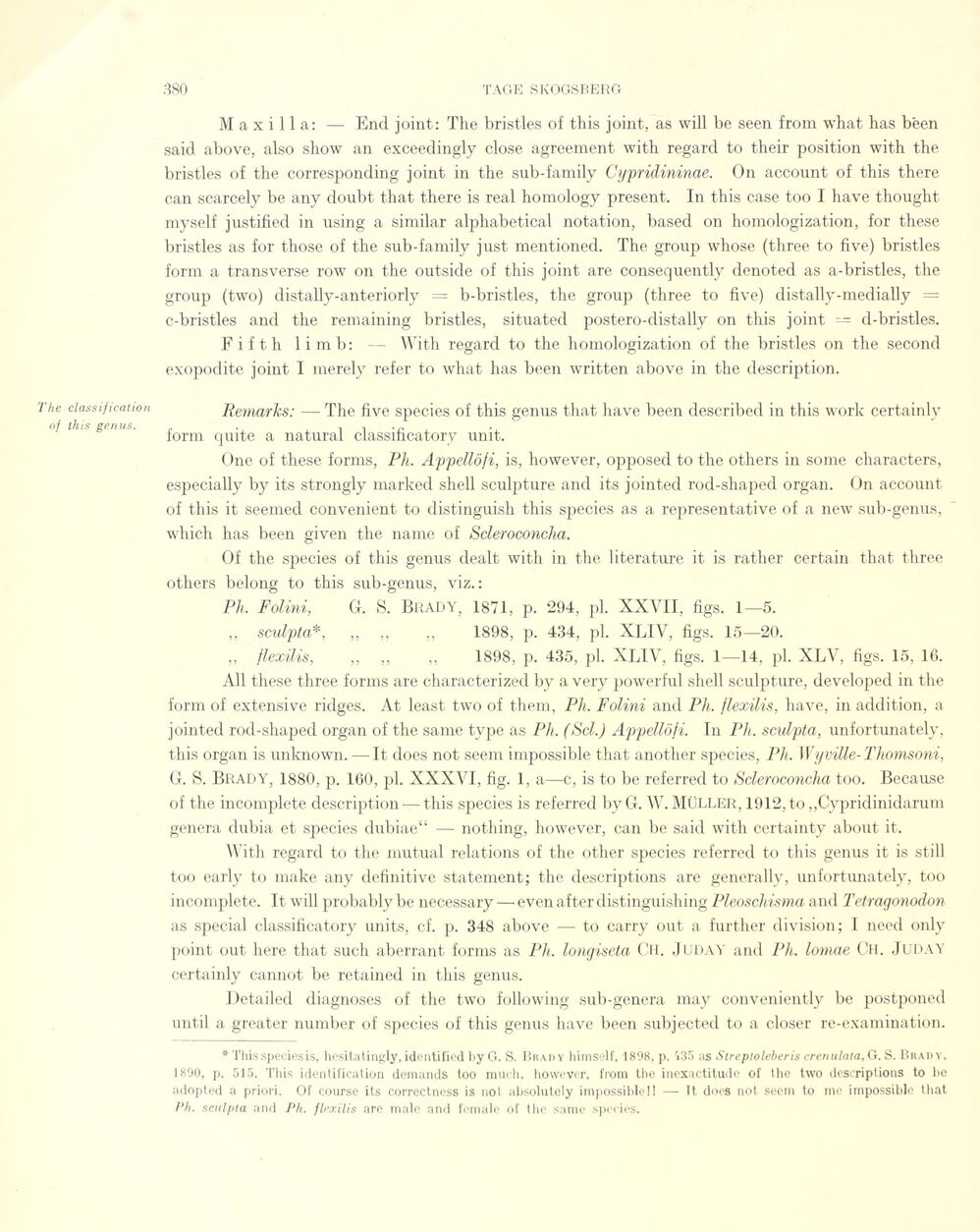
Full resolution (JPEG) - On this page / på denna sida - Sidor ...

<< prev. page << föreg. sida << >> nästa sida >> next page >>
Below is the raw OCR text
from the above scanned image.
Do you see an error? Proofread the page now!
Här nedan syns maskintolkade texten från faksimilbilden ovan.
Ser du något fel? Korrekturläs sidan nu!
This page has never been proofread. / Denna sida har aldrig korrekturlästs.
Maxilla: — End joint: The bristles of this joint, as will be seen from what has been
said above, also show an exceedingly close agreement with regard to their position with the
bristles of the corresponding joint in the sub-family Cypridininae. On account of this there
can scarcely be any doubt that there is real homology present. In this case too I have thought
myself justified in using a similar alphabetical notation, based on homologization, for these
bristles as for those of the sub-family just mentioned. The group whose (three to five) bristles
form a transverse row on the outside of this joint are consequently denoted as a-bristles, the
group (two) distally-anteriorly = b-bristles, the group (three to five) distally-medially =
c-bristles and the remaining bristles, situated postero-distally on this joint — d-bristles.
F i f t h 1 i m b : — With regard to the homologization of the bristles on the second
exopodite joint I merely refer to wliat has been written above in the description.
The classification Remarks: —- The five species of this genus that have been described in this work certainly
lh’ p""’’ form quite a natural classificatory unit.
One of these forms, Ph. Appettöfi, is, however, opposed to the others in some characters,
especially by its strongly marked shell sculpture and its jointed rod-shaped organ. On account
of this it seemed convenient to distinguish this species as a representative of a new sub-genus,
which has been given the name of Scleroconcha.
Of the species of this genus dealt with in the literature it is rather certain that three
others belong to this sub-genus, viz. :
Ph. Folini, G. S. Braby, 1871, p. 294, pi. XXVII, figs. 1—5.
,, sculpta*, ,, ,, ,, 1898, p. 434, pi. XLIV, figs. 15—20.
,, flexilis, ,, ,, ,, 1898, p. 435, pi. XLIV, figs. 1—14, pi. XLV, figs. 15, 16.
All these three forms are characterized by a very powerful shell sculpture, developed in the
form of extensive ridges. At least two of them, Ph. Folini and Ph. flexilis, have, in addition, a
jointed rod-shaped organ of the same type as Ph. (Scl.) Appellöf i. In Pli. sculpta, unfortunately,
this organ is unknown. — It does not seem impossible that another species, Ph. Wyville- Thomsoni,
G. S. BRABY, 1880, p. 160, pi. XXXVI, fig. 1, a—c, is to be referred to Scleroconcha too. Because
of the incomplete description — this species is referred by G. W. MÜLLER, 1912, to „Cypridinidarum
genera dubia et species dubiae“ — nothing, however, can be said with certainty about it.
With regard to the mutual relations of the other species referred to this genus it is still
too early to make any definitive statement; the descriptions are generally, unfortunately, too
incomplete. It will probably be necessary — even after distinguishing Pleoschisma and Tetragonodon
as special classificatory units, cf. p. 348 above — to carry out a further division; I need only
point out liere that such aberrant forms as Ph. longiseta Ch. Jubay and Ph. lomae Ch. JUBAY
certainly cannot be retained in this genus.
Detailed diagnoses of the two following sub-genera may conveniently be postponed
until a greater number of species of this genus have been subjected to a doser re-examination.
* This species is, hésitaiingly, identified by G. S. Brady himself, 1898, p. 135 as Streptoleberis crenulata, G. S. Brad y,
1890, p. 515. This identification demands too much, however, from the inexactitude of the two descriptions to be
adopted a priori. Of course its correctness is not absolutely impossible!! — Tt does not seem to me impossible that
Ph. sculpta and Ph. flexilis are male and female of the same species.
<< prev. page << föreg. sida << >> nästa sida >> next page >>